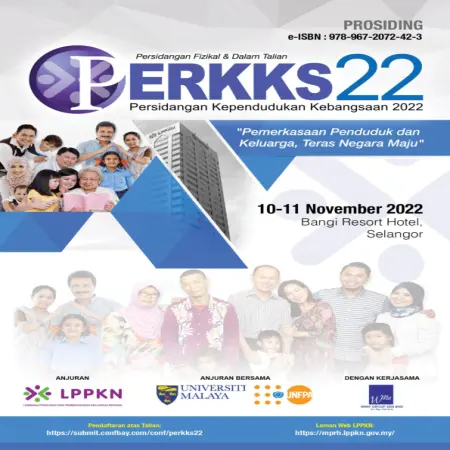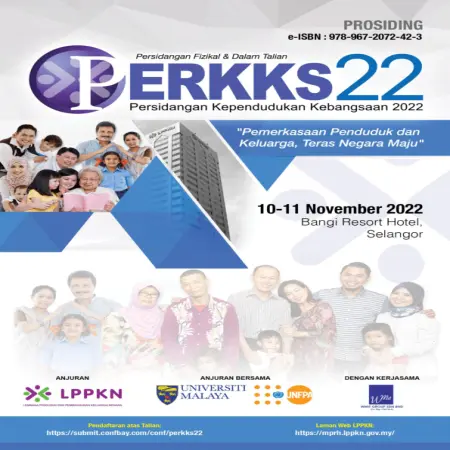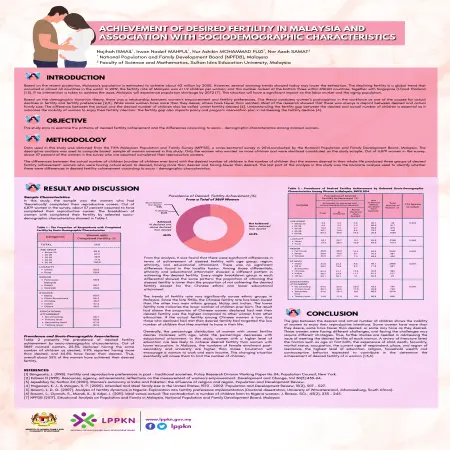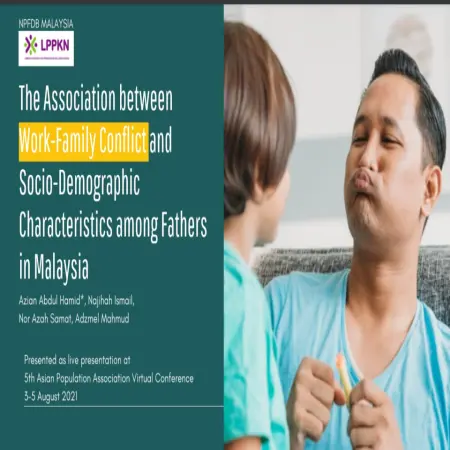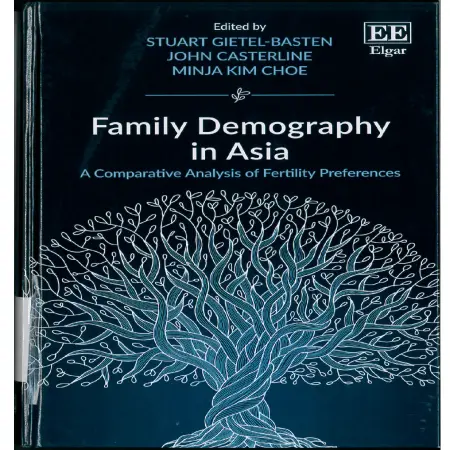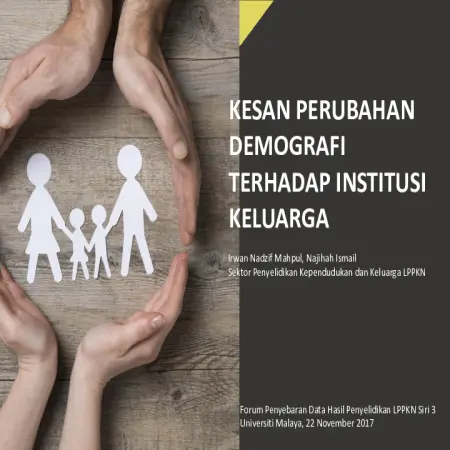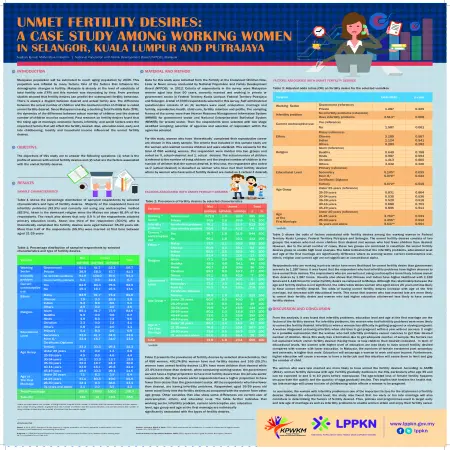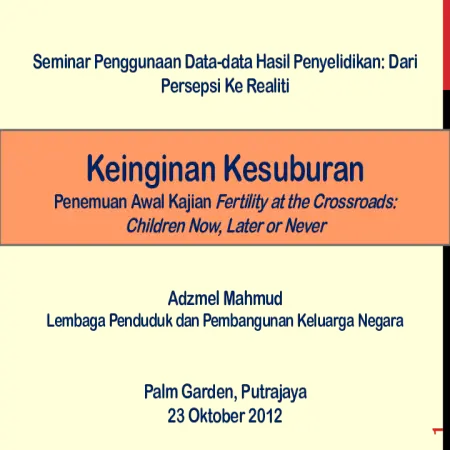Browse by Author
Results for Family Name : "Ismail" AND Given Name/Initial : "Najihah"
|
|
Penurunan kadar kesuburan penduduk di Malaysia: Implikasi dan intervensi
Item Type: Book Section
Editor:
Year: 00/00/2022
Abstract: The fertility rate of the national population has decreased from 6.8 children in 1957 to 4.9 children in 1970. This rate continued to decline to 3.9 in 1980, 3.3 in 1990, 2.7 in 2000, 2.2 in 2010 and then 1.7 in 2020. The United Nations projects that the fertility rate of the country’s population will remain at a level between 1.7 and 1.8 until 2100.
|
|
|
|
|
|
Stress dan tahap kesejahteraan sosial pasca pandemik covid19: Satu tinjauan
Item Type: Book Section
Editor:
Year: 00/00/2022
Abstract: Since the start of the Coronavirus Disease 19 (COVID-19) pandemic in late 2019, the highest daily deaths recorded in Malaysia were 408 and until the end of the pandemic period, on 30 March 2022, the cumulative death toll was over 35,800 deaths. Throughout the pandemic phase, every Malaysian individual of all ages, races and economic social backgrounds received the impact of the phased implementation of the Phased Movement Control Order policy implemented by the government. This paper aims to identify the factors that influence the level of stress of parents during the post COVID-19 pandemic in Malaysia.
|
|
|
|
|
|
Achievement of desired fertility in Malaysia and association with sociodemographic characteristics
Item Type: Scientific Poster
Editor:
Year: 00/00/2021
Abstract: This study aims to examine the patterns of desired fertility achievement and the differences according to socio - demographic characteristics among married women.
|
|
|
|
|
|
The association between work family conflict and social demographic characteristics among fathers in Malaysia
Item Type: Conference or Workshop Item
Editor:
Year: 00/00/2021
Abstract: Those living in urban, Indian, age 30-44 years, higher educational level, single father, and non Muslim’s tend to face Work Family Conflict than their counterparts. More hectic/busy environment and higher cost of living in urban area compared to the rural area may contribute to the Work Family Conflict among fathers.
|
|
|
|
|
|
Trends and variations in contraceptive use in Malaysia
Item Type: Book Section
Editor:
Year: 00/00/2021
Abstract: The contraceptive prevalence rate (CPR-the proportion of married women in the reproductive age group using any family planning method) in Malaysia CPR had stagnated since the mid-1980s when the government shifted its programme thrust from family planning to family development.
|
|
|
|
|
|
Fertility preferences in Malaysia
Item Type: Book Section
Editor:
Year: 30/11/2018
Abstract: Most countries have been experiencing changes in fertility pattern over the last few decades. Fertility transition from high to low is a relatively recent phenomenon in Malaysia. The total fertility rate (TFR) had declined from 4.9 children per woman in 1970 to 4.0 in 1980. It has continued to fall and has reached the replacement level of 2.1 in 2010. This chapter provides the trend analysis and a comparative analysis of fertility trends to explain the fertility transition of Malaysia’s population. Data used in this study were obtained from Department of Statistics, Malaysia and Fifth Malaysian Population and Family Survey, 2014. The result of this study showed that the fertility rate between age groups was higher among Malay than other ethnics since 1991–2010. Across all ages, the fertility rate has a negative correlation with the educational level where women with tertiary education tend to have fewer children compared to less educated women. This study also presents the fertility desire in Malaysia. There is a negative correlation between age group and fertility desire. In addition, the desire to stop childbearing is found to be stronger when women have had three living children. The findings of this study will help policy makers to plan programmes to improve the fertility rate in Malaysia.
|
|
|
|
|
|
Kesan perubahan demografi terhadap institusi keluarga
Item Type: Conference or Workshop Item
Editor:
Year: 00/00/2017
Abstract: Since the 1980s, the fertility rate (TFR) has declined slowly from 4.0 to 2.0 children per woman in 2016. This means that every woman in the country at this point , on average, gives birth to 2 children in her lifetime. The rapid decline in fertility rate (TFR) has accelerated the aging process of the country. The TFR is likely to remain between 1.9 and 2.0 by 2020 and below 1.9 in the next decade. This presentation is about the impact of demographic change on family institutions.
|
|
|
|
|
|
Unmet fertility desires: a case study among working women in Selangor, Kuala Lumpur and Putrajaya
Item Type: Scientific Poster
Editor:
Year: 00/00/2015
Abstract: Malaysia population will be estimated to reach aging population by 2035. This projection was inflated by many factors. One of the factors that influence the demographic changes is fertility. Malaysia is already at the level of substitute of total fertility rate (TFR) and this number was decreasing by time. From previous studies showed that fertility desires can predict the subsequent fertility behavior. There is always a disjoint between desired and actual family size. The difference between the actual number of children and the desired number of children is called unmet fertility desired. Since Malaysia is having a declining Total Fertility Rate (TFR), the dynamics of the difference between actual number of children and the desired number of children must be examined. Past research on fertility desires found that the rising age at marriage, economic factors, infertility, and social factors were the important factors that will affect the fertility desired. Also, education level, early and late childbearing, locality and household income influenced the unmet fertility desires.
|
|
|
|
|
|
Keinginan kesuburan
Item Type: Conference or Workshop Item
Editor:
Year: 00/00/2012
Abstract: The decline in fertility rates in Malaysia is happening rapidly and it is expected that the rate will reach the replacement level (replacement level = 2.1) in 2015. A woman's desire/decision to have a child has a direct impact on the fertility rate and population growth. Thus, the study aims to identify the factors that influence women's desire to have children or do not need to be implemented. Data and Methodology: This paper presents the preliminary findings of the study Fertility at the Crossroad: Children Now, Later or Never conducted by LPPKN in 2012. This study uses a cross -sectional survey design method with a focus on women in the reproductive age group. 15-49 years working in the public sector in Kuala Lumpur, Putrajaya and Selangor. The method of data collection was through face -to -face interviews and self -administered using a questionnaire. Through stratified sampling method, a total of 98 public sector agencies were selected. To achieve the objectives of the study, the data obtained were analyzed using Descriptive Statistics, Chi Square and Logistic Regression (Forward LR Method). The dependent variable studied was the desire to have children (0 = do not want more children, 1 = want more children). While there are nine (9) independent variables studied namely age, ethnicity, education level, job grade (Management and Professional/Support), income, number of childbirths, pregnancy history (miscarriage/stillbirth/abortion), fertility problems and The husband lives far away. Findings: In total, a total of 1,898 data for women working in the public sector were analyzed. A total of 75.9% of respondents have a desire to have children. The results of Chi -Square analysis showed that the variables of age, ethnicity, income, number of births, pregnancy history, fertility problems and husbands living far apart had a significant relationship with the desire to have children. However, there is no evidence to suggest that post grade has a relationship with childbearing desire. Logistic regression test (Forward LR Method) showed that 57.8% of the variation in women's desire to have children can be explained by four independent variables, namely fertility problems, ethnicity, age and number of births. Conclusion: The results of the study found that women's desire to have children can be considered high. To support women's desire to have children, various forms of assistance/support should be provided by the employer/government. Among the main assistance/support needed are childcare centers at work, holiday facilities to care for sick children, subsidized childcare costs and full-paid facilities for children in need of special care.
|
|
|
|





